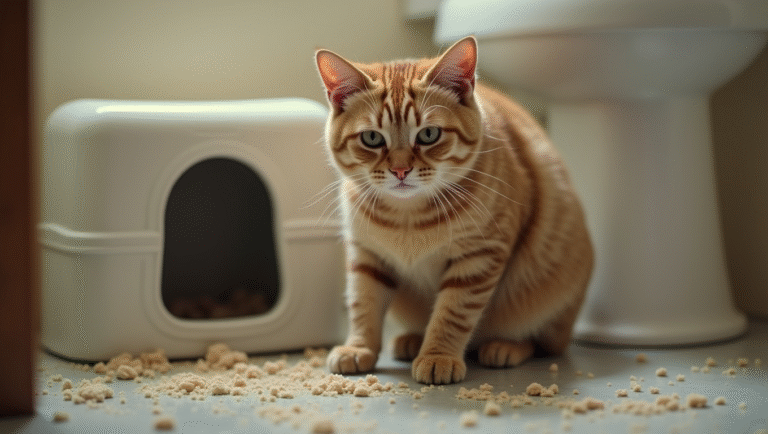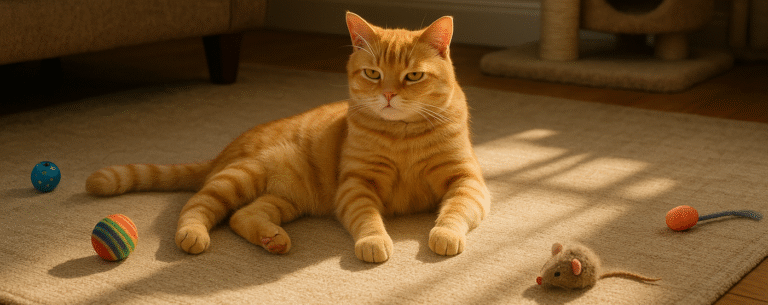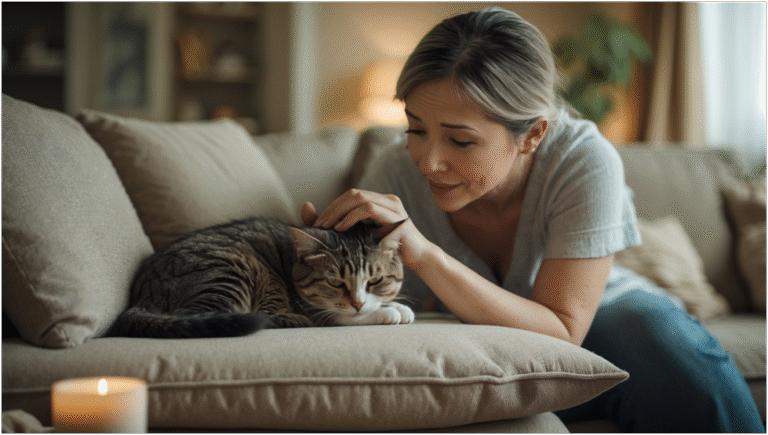How to Recognize and Manage Scared Cat Behavior: Signs, Triggers, and Calming Solutions
As a cat owner, you know that your feline friend has a mysterious way of expressing themselves. But what happens when those cute quirks turn into signs of fear and anxiety? Scared cat behavior is often subtle but can quickly escalate if left unaddressed. Cats, like us, experience stress, and understanding their behavior can make all the difference in helping them feel safe. In this guide, we’re going to walk you through how to recognize when your cat is scared, identify the signs of anxiety, and discover effective ways to help them. Whether you’re a first-time cat parent or a seasoned pro, you’re about to learn how to make your home a safe haven for your scared cat.
What Does It Mean When Your Cat is Scared?
If your cat is scared, you’ll notice a shift in their usual behavior. A scared cat is a feline showing signs of fear or anxiety in response to a perceived threat. That might be a loud sound, a new person, or even an unfamiliar change in their environment. Recognizing scared cat behavior early can help prevent more severe issues from developing. Cats can’t always verbalize their stress, so it’s up to you to recognize the signs. If your cat is hiding more often, being overly vocal, or acting aggressively, these could be signs they’re in distress.
Why Do Cats Get Scared?
There are lots of reasons your cat might get scared. Loud noises, like vacuum cleaners, fireworks, or thunderstorms, can trigger anxiety. New people or pets may also make them feel uneasy, as they feel their territory is being threatened. Even changes in routine or the environment, such as moving furniture or switching food brands, can cause anxiety. Past trauma, especially from kittenhood, insufficient socialization, or negative experiences at the vet, can also play a role. Recognizing these triggers early can help you create a calm, safe environment for your kitty.
Recognizing Signs of a Scared Cat
How Can You Tell If Your Cat is Scared?
You know your cat better than anyone, but sometimes, it’s hard to know what their behaviors really mean. A scared cat will show you exactly how they’re feeling if you know what to look for. From subtle signs to more intense reactions, these behaviors are their way of telling you they’re anxious. And guess what? Around 33% of cats will develop stress-related health issues if anxiety isn’t managed properly. So, let’s dive into the most common signs you should be aware of:
Body Language Indicators of Fear
- Flattened or Sideways-Turned Ears: If your cat flattens their ears, it’s a clear sign they’re feeling threatened. Studies show that 68% of anxious cats show this behavior. It’s their way of saying, “I’m stressed—back off!”
- Whiskers Pulled Close to the Face: When you notice your cat’s whiskers pulled tightly back towards their face, it’s a sign of stress. This is a defensive gesture—they’re trying to make themselves appear smaller to avoid detection by any potential threat.
- Arched Body Posture: An arched back is one of the most obvious signals that your cat is frightened or on edge. About 80% of stressed cats show this posture, trying to make themselves appear larger to deter whatever is stressing them out.
- Tucked Tail or Rapid Lashing Movements: A tucked tail signals that your cat is fearful or submissive. Rapid tail flicks or lashing often signal that your cat’s anxiety is building, and they might soon lash out or try to escape.
- Dilated Pupils: Dilated pupils are one of the easiest signs to spot when your cat is scared. Their pupils widen in response to fear, signaling their heightened alertness. 72% of cats show pupil dilation when they’re anxious or alarmed.
- Subtle Crouching: Before your cat gets into full fight-or-flight mode, you might see them crouch low to the ground. This behavior is an instinctive way of making themselves less visible to potential threats.

“A close-up of a cat with wide eyes and a cautious, alert posture, displaying typical signs of fear and anxiety, including flattened ears and a tense body.”
Bad Behavior Linked to Fear
It’s important to remember that many of the “bad behaviors” we see in our cats—scratching, urinating outside the litter box, hiding—are often driven by stress and fear. In fact, about 20% of these behaviors are directly linked to anxiety in cats. By addressing the root causes of their fear, rather than just the symptoms, you can help your cat feel more secure and reduce those unwanted behaviors.
Key Triggers of Cat Anxiety
Common Anxiety Triggers in Cats
Understanding what causes cat anxiety is key to helping your cat feel secure again. Let’s explore the most common triggers that might be stressing your fur baby out:
- Environmental Stressors: Cats are territorial animals, and even small changes in their environment can cause stress. Remodelling, new furniture, unfamiliar scents, or even a change in the position of their food or water bowl can be stressful. About 33% of cats experience anxiety from environmental changes. Keep their environment predictable and comforting—add cozy hiding spots, familiar scents, and enriching toys.
- Unfamiliar People or Pets: Introducing new people or pets into your home can be a big deal for your cat. Cats are territorial by nature, and having strangers or other animals around can make them feel uneasy. Gradual introductions work wonders here. Start by letting your cat observe new arrivals from a distance in a quiet space.
- Loud Noises and Sudden Movements: Cats have super-sensitive hearing, and loud sounds like fireworks or thunderstorms can be terrifying for them. Restlessness, hiding, or vocalizing during these times are common signs that your cat is scared. Creating a safe space with comforting items can help reduce stress during loud events.

“A cat hiding under a couch in a living room with a vacuum cleaner visible in the background, demonstrating the stress caused by loud household noises.”
- Past Trauma Experiences: Cats with past trauma or a lack of early socialization are often more prone to fear. Studies show that up to 20% of shelter cats struggle with anxiety due to past trauma. Patience, positive reinforcement, and a calm environment are key to helping them overcome their fears.
Creating a Safe Space for Your Scared Cat
Why a Safe Space is Crucial for Reducing Stress?
Creating a safe space for your scared cat is one of the most effective ways to reduce stress and anxiety. Cats are sensitive to environmental changes, and a secure retreat can significantly help. Studies show 60% of cats with safe zones experience reduced anxiety and fewer stress behaviors. This designated space allows your cat to retreat when overwhelmed, reducing problem behaviors like hiding or aggression. Over time, it helps manage anxiety and reduces fear of new experiences and changes.
How to Create an Effective Safe Space for Your Cat
Designing a calming environment doesn’t need to be complicated. By following a few simple steps, you can create a cozy retreat that helps your cat feel safe and relaxed. Here’s how you can build a space where your cat can retreat when feeling scared:
- Pick the Right Spot: The location of your cat’s safe space is essential. Choose a quiet, low-traffic area away from household noise and distractions. Ideally, this space should be high up or secluded, mimicking a cat’s instinct to seek height for security. 40% of cats prefer elevated spots to feel safer.
- Make It Cozy: Comfort is key. Provide a soft bed, blanket, or even a cat cave where your cat can snuggle up. Soft bedding can help reduce your cat’s stress and make the space feel more inviting. Make sure it’s warm, as cats are more likely to retreat to warmer areas when they’re anxious.
- Keep Essentials Nearby: Place food, water, and a litter box close to your cat’s safe zone. When your cat feels cornered or trapped by too many obstacles, it increases their anxiety. Keeping essential items within reach means they can feel secure enough to eat, drink, or relieve themselves without feeling vulnerable.
- Include Familiar Items: Familiar scents help create a sense of security for your cat. Add their favorite toys, a piece of your clothing, or a blanket that smells like them. If your cat has a particular object they love, make sure it’s included in their safe area. Cats are scent-oriented creatures, and familiar smells can have a calming effect.
- Consider Calming Products: If your cat is still struggling with anxiety, you can introduce pheromone diffusers like Feliway. These products release synthetic pheromones that mimic those produced by a mother cat, which have been shown to promote relaxation. Studies show that 70% of cats exposed to pheromone diffusers exhibit less anxiety, helping them feel more at ease in their safe space.
Creating a safe space for your cat will not only provide immediate relief during moments of stress but will also help build a sense of security over time, making them feel more comfortable and less anxious in the long run.

“A cozy and secluded cat safe space with soft bedding, blankets, and familiar toys, providing a secure retreat for a stressed cat.”
Effective Calming Techniques for Scared Cats
When your cat is scared, it can be difficult to know how to help them calm down. Fortunately, there are several effective calming techniques to ease your cat’s anxiety. These strategies, when used consistently, can significantly reduce the signs of scared cat behavior. Let’s explore some of the best methods:
Using Pheromone Diffusers and Sprays
One of the most reliable ways to soothe a nervous cat is by using pheromone diffusers and sprays. Feliway, for example, mimics the natural pheromones that cats use to mark territory and communicate a sense of safety. Research indicates that 70% of cats show improved relaxation and reduced anxiety when exposed to these calming pheromones. For fearful cats, this can be a game-changer, helping them feel more secure in unfamiliar environments or when confronted with stressful triggers.
Interactive Play for Stress Relief
Interactive play is not only fun but also an excellent way to relieve stress and anxiety in cats. Toys that mimic prey, like feather wands or laser pointers, stimulate your cat’s natural hunting instincts, which can help reduce excess energy and tension. A study by the University of Lincoln found that regular play sessions with a predatory stimulation toy can help reduce anxiety by providing mental stimulation and stress relief. Around 65% of cats with regular play sessions demonstrate lower stress levels and increased confidence.

“A cat jumping and playing with a feather wand, engaging in interactive play to relieve stress and anxiety.”
Establishing a Consistent Routine
Cats are creatures of habit, and they thrive on routine. A consistent schedule for feeding, playtime, and quiet time can significantly reduce anxiety in fearful cats. Studies show that about 60% of anxious cats benefit from a predictable daily schedule. When cats know what to expect, they feel more secure and are less likely to become stressed or fearful. Consistent meal times, along with regular play sessions, can help manage your cat’s anxiety and prevent behavioral issues.
Establishing a routine creates a sense of stability, helping your cat feel safer and more comfortable. Over time, this consistency can help them handle unpredictable situations with greater ease, knowing they have control over their environment.
Gradual Socialization for Anxious Cats
Introducing New People and Pets Slowly
Socializing a scared cat takes time and patience. Gradual introductions to new people or pets are essential in helping your cat adjust to unfamiliar situations. Research from Veterinary Behaviorists indicates that cats introduced slowly to new environments or companions experience significantly less anxiety compared to those who are overwhelmed by sudden changes. It’s important to never rush the process. Allow your cat to approach new situations at their own pace. Gradual introductions help build trust and reduce stress.

“A cat observing a puppy from a safe distance, illustrating a gradual, calm introduction between new pets in a peaceful home environment.”
Building Trust with Positive Reinforcement
Positive reinforcement is a powerful tool for building trust and encouraging calm behavior in a fearful cat. Whenever your cat shows signs of relaxation or calmness in a stressful situation, reward them with treats or affection. This reinforces the behavior and increases their confidence. A study published by ASPCA found that rewarding calm behavior in anxious cats helps them gradually overcome fears and build a sense of security.
By focusing on gradual socialization and positive reinforcement, you can help your cat feel more comfortable in their environment and increase their ability to cope with fear-inducing experiences.
Long-Term Strategies for Managing Cat Anxiety
Long-term management of cat anxiety requires consistent attention, observation, and sometimes professional guidance. If your cat’s fear or anxiety persists, it may be time to consider professional help. Here are a few strategies to help you manage your cat’s anxiety over the long term:
Creating a Consistent, Enriching Environment
Ensuring that your cat’s environment is consistently enriching is vital for long-term anxiety management. Cats thrive in environments that offer plenty of mental stimulation and physical outlets. Interactive toys, scratching posts, and puzzle feeders can keep your cat engaged and reduce the likelihood of stress behaviors. An enriched environment can provide positive distractions and reduce the impact of stressors on your cat’s emotional health.
Consulting a Veterinarian or Behaviorist
If your cat’s anxiety continues despite your efforts, it may be time to consult a professional. A veterinarian or animal behaviorist can provide personalized guidance on your cat’s anxiety management, including the use of medication or more advanced behavioral techniques. Studies show that behavioral therapy combined with medication can be effective for treating severe anxiety in cats. If your cat is exhibiting chronic symptoms of stress, seeking help from an expert is a critical step toward improving their quality of life.
Faqs
· Why is my cat suddenly scared of me?
Sudden fear may result from negative experiences, health issues, or environmental changes. Rebuild trust by allowing your cat to approach you, avoiding sudden movements, and offering treats or toys as positive reinforcement.
· How can I tell if my cat is scared or just being aloof?
Fearful cats exhibit signs like hiding, flattened ears, dilated pupils, and a tucked tail. Aloof cats may prefer solitude without displaying stress-related behaviors.
· What should I do if my cat is scared of strangers?
Gradually introduce strangers by allowing your cat to observe from a distance. Use positive reinforcement, such as treats and gentle encouragement, to help your cat associate new people with positive experiences.
· Can scared cats become aggressive?
Yes, fear can lead to aggression as a defense mechanism. Signs include hissing, growling, swatting, or biting. Addressing the underlying fear is crucial to prevent escalation.
· How can I help my fearful cat become more social?
Create a safe space with essential resources. Gradually introduce positive interactions, such as playtime and gentle petting, using tools like wand toys initially. Be patient and consistent in your approach.
· Can I use calming products to help my scared cat?
Yes, products like pheromone diffusers (e.g., Feliway) release synthetic cat pheromones that promote relaxation. Studies show that 70% of cats exposed to these pheromones exhibit reduced anxiety.
· How can I help my cat overcome a fear of the litter box?
Ensure the litter box is in a quiet, low-traffic area and maintain cleanliness. If avoidance continues, try different litter types or provide multiple boxes in various locations. Consult a veterinarian if issues persist.






